Lisbon part 1
Day 1
Two summers ago, we spent a week in Lisbon which was enough time for us to enjoy this beautiful city at our own pace. We rented nice duplex apartment with 3 bedrooms in the heart of bairro de Alfama. Two of the bedrooms were upstairs, with a slanted ceiling lined with wooden slats, fitted out with light pine furniture and matching carpets with curtains and cushions.
We had a little balcony from which we could see the cruise ships which were docked in the port. It was fitted out with everything we could need: towels, bed sheets, kitchenware, including coffee, tea, sugar, oil, salt, vinegar, serviettes, toilet paper and much more. In the kitchen there was a coffee machine, toaster, microwave, a pressure cooker, etc. The only problem was the stairs, they were very steep and narrow and our apartment was on the third floor with no lift. The street was very pedestrian and we couldn't get our car up to the front door, but the apartment was very close to Santa Apolonia train station and there was parking there.
A brief history of Lisbon
Throughout the history of Lisbon there have been moments of great splendour and moments in which the city nearly lay in ruin; but everything worked out in the end. Lisbon also hosted the universal exhibition in 1998 which was dedicated to the ocean.
There is legend that says that Ulysses founded the city when he returned home from the Trojan War and he named the city "Olissipo". The city was actually founded by the Phoenicians in the 12th century BC.
Its privileged location is at the mouth of the Tagus river which meant that the city also benefited from maritime trade making it well sought after by the Phoenicians, Carthaginians and Greeks. The Romans conquered the city in 205 BC and named it "Felicitas Julia" since it was the first main city on the Iberian peninsula in Julius Caesar's time. After the fall of the Roman Empire it was taken over by barbaric tribes.
In 711 AD, the Arabs took hold of the Visigoths which is shown through landmarks that have been left behind like San Jorge castle and "Bairro Alfama". In the year 1147, Alfonso I expelled the Muslims and he ordered the construction of the Se cathedral where the remains of Saint Vincent, the patron of Lisbon and a martyr who fought against the Arabs, were resting. In 1256, Lisbon was named the capital city of Portugal by King Alfonso III and a large commercial and cultural expansion took hold of the city. Don Dinis, the King's son, founded Lisbon university in 1209 and later founded Coimbra university.
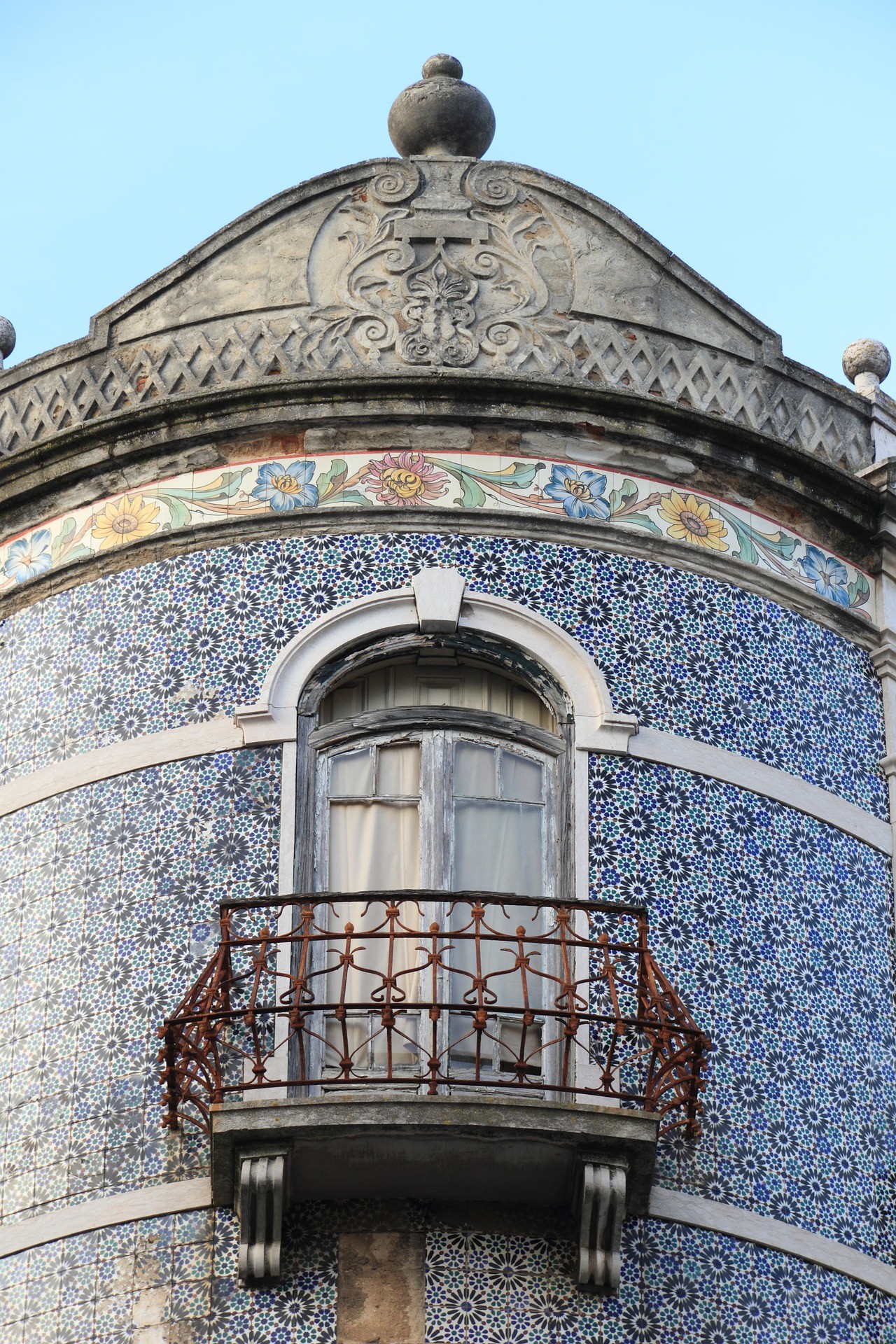
An example of a building with Arab influences
In 1373, Lisbon was invaded by Enrique II of Spain so Fernando I fortified the city in order to avoid more invasions. Thanks to the plague, the city was in ruin and so arrived the era when Lisbon was declining. The city started to recuperate during the era of discovery. Inspired by the discovery of Christopher Colombus, Vasco da Gama went to sea in 1497 and by following the Border of Africa, he made his way to India.
Lisbon happened to be a very enriched city thanks to the commerce and the riches that came from Brazil. In 1531, Lisbon suffered an earthquake. Manuel I, the reining King at the time, built the Jerónimos Monastery and the tower of Belem in the hopes for prosperity. "Bairro Alto" and the commercial square were built in the 16th century. With the inquisition came terror and it was in the commercial square where the executions took place.

Belem Tower
In 1580 Sebastián I died without having produced any offspring, and therefore an heir to the throne, so the Spanish took advantage of the opportunity and seized Portugal until 1640 when Joâo V was named King. He ordered the construction of the aqueducts which brought water from the valley of Alcántara. Misfortune returned in the form of another earthquake in 1755 which completely destroyed everything. The reconstruction of the Pombal Marquess is approved but it's interrupted by Napoleon's invasion. King José I moved the court to Rio De Janeiro and up until a hundred years later, the Arcul de Triumf has still not been built.
Then, in the 19th century, motorways and highways were built, railways were built and they started to install trams and a wall along the banks of the river which frequently overflowed. King Carlos and his son were assassinated in 1908, which brings about the end of the monarchy and the start of a 42 year long dictatorship. The Salazar bridge is built, today it's called "Ponte 25 de Abril" to commemorate the end of the dictatorship in 1974.
In 1986, Lisbon applied to form a part of the European Union. A horrible fire destroyed Chiado in 1988 with a irreplaceable loss of patrimony. Its reconstruction was entrusted to architect Alvaro Siza Vieira. It was made a European capital in 1994 and a universal city in 1998 when it paid tribute to it's marine history.

The Districts
We had grilled fish for lunch (very tasty), in a bar in Alfama and we went to see the monuments. The city was perfect for walking to Se cathedral. We immersed ourselves in the heart of medieval Lisbon and passed through Alfama - we discovered that boots were the best footwear since the streets are all cobbled.
Lisbon is divided into 5 districts: La Baixa, Alfama, Belem, Chiado and Barrio Alto and the "Parque das Nações".
Alfama
Alfama is a very modest district, it used to be a fishing village. It's found at the foot of San Jorge castillo. It's also the oldest zone with Arabic origins. It hasn't changed much because it hardly suffered any damage during the earthquake. The world Alfama means al-hamma(hot baths). It's already known that it was occupied during Roman times. It's a good place to stroll along the cobbled, steep and narrow streets, it even has streets with stairs! There are small businesses that offer have a little bit of anything that you could need. The main street in Alfama is "Rua Sâo Miguel", which is home to San Miguel church. It's full of butchers, fishmongers and small bars - all very cute. At dusk, its many restaurants put their tables outside and adorn them with tablecloths which are patterned with little red and white squares. A fado singer accompanied by only a guitar usually sits in the doorway and sings nice songs which always seem to be a bit sad.
We ate dinner in the apartment to save some money and because we were very tired but before we made a quick journey to the supermarket, "Pingo Doce", near Saint Apolonia station. It's a chain of very good and cheap Portuguese supemarkets. They have ready meals, cooked seafood and roasted chicken which what we ate for dinner - chicken in a lemon sauce. To add to this, there's also a MacDonalds in the train station.
We ate breakfast in the apartment and we went to walk around Lisbon... in comfortable shoes this time!
Earlier in the morning, we went to see the fish market that is put up on "Rua Sâo Pedro" every morning. It was full of stalls selling fresh fish. The fishmongers would shout out their offers for the fish. We also found our way over to the "Se cathedral".
Se Cathedral
In the year 714, Lisbon used to belong to the Arabs that built a mosque. In the year 1147, it was conquered by Alfonso Henriquez, the King of Portugal, who appointed Gilbert Hasting as Archbishop of Lisbon. In 1150, they ordered the construction of a cathedral on top of the mosque. In fact, remains had been found during excavations carried out in the cloister of the Se. It has endured earthquakes and fires. It was firstly "la iglesia Santa Maria la Mayor", it wasn't a cathedral until 1393 when Joao I was King.
On the façade of the building we saw two massive bulls and in the centre, a rose window in the style of the romantic period. The interior is very dark, we saw chapels in a Gothic style and the altar that had been added after the earthquake. During the 18th century, the interior used to be covered in decorations, but they were destroyed during the earthquake. The last works done on the building had been done in a more medieval style. We saw the tombs of King Alfonso IV and his wife, Beatriz and of a friend who was in the military: Lopo Fernandes Pacheco and his wife with sculptures of them and their dogs on the tombs.
The remains of San Vincent, the patron of Lisbon, were brought to this church from the south in 1173. Legend has it that 2 ravens were protecting the coffin during the journey from the south, so ravens have been incorporated into the Portuguese coat of arms. Behind the altar there is a space called a "girola" where pilgrims used to come to pray.
In the treasury, we saw sacred objects and religious clothing. We also went to the cloister which was had a Romanesque-Gothic ceilings and arches. In the centre, we expected to see the typical garden, but instead we found an archaeological excavation site where a lot of the history of Lisbon had been found. We could see into the excavation site from the walkway which surrounds it. There was a part of a Roman wall, a street with stairs, remains of medieval buildings and even part of a medieval wall.
The entrance fee is not at all expensive.
From here, we went to the Church of Saint Anthony in the Largo de Santo Antonio.
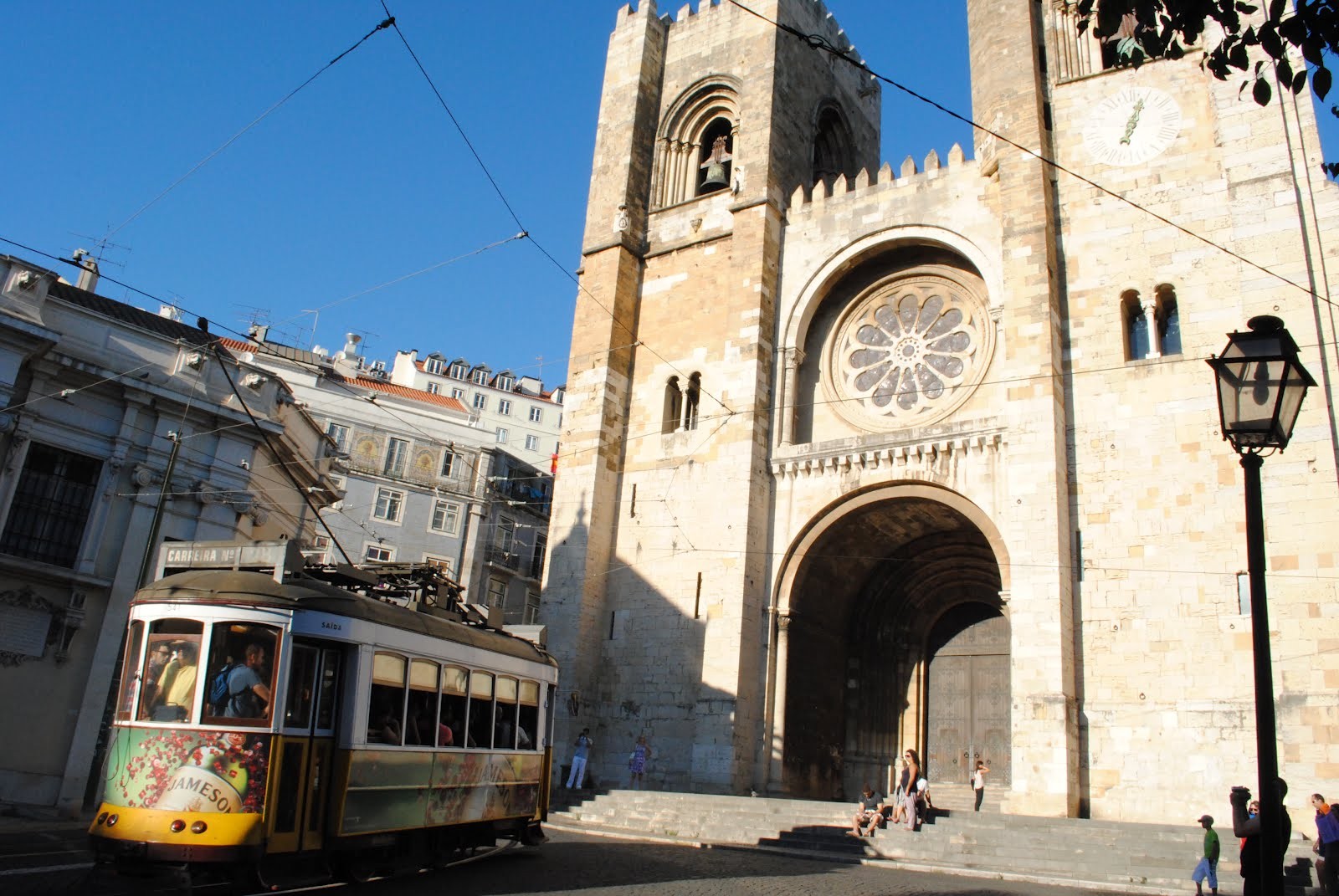
Church and museum of Saint Anthony
Saint Anthony of Padua is not the patron but he is very dear to Lisbon as he was born in Lisbon around 1190, he walked from Morocco when his boat was shipwrecked and he settled down in Padua. He died in 1231 and he was buried in Padua, being the place where he did his pilgrimage. He was born in the place where the church and museum have been built. Just like everything in Lisbon, the church was destroyed and what we see today was actually built in 1787, and decorated in the Baroque style.
On the 12th June each year, 16 couples are married at the same time, this day is known as Saint Anthony eve. The following day, there is a procession up to the cathedral through all the small streets in Alfama and in the evening, sardines are roasted and a large quantity of wine is drunk in the street. In the museum, we saw paintings, sculptures and biographical documents that helped us to get to know the Saint a little better.
The entrance fee is cheap.
We went up to the "Rua do Electrico" and we arrived at the Portas do Sol and we stopped on the beautiful lookout gazebo of Santa Lucía where we saw some spectacular views. Next, we saw the church of Santa Lucía, which gave it's name to the lookout point, and was adorned in blue tiles from the 18th century. We continued on to the left of the church for the length of the "Portas do Sol" where we found the school and museum of decorative arts.
Museum and school of decorative arts
We found this place settled in the Azurara Palace and it was built in the 17th century. We saw a very pretty collection of furniture, porcelains and paintings. The rooms where we saw these collections were decorated how they would have been in their day in the houses of wealthy people. This museum is from the year 1947, the same year in which the palace was purchased by Ricardo do Espirito Santo da Silva, a great lover of 17th and 18th century furniture.
It's decorated in complete detail, as if it was actually being lived in. Some years after the museum was built, it was a training school where they taught (and still do teach today) all the different sub-categories of art. In the studios, they make orders which are sent all around the world. In the lobby, there is a tiled staircase. When climbing the stairs, we reached a 3 rooms with low ceilings, richly furnished and the floors were made of hand-stitched carpeting in Arraiolo, a factory that we could visit.
The Chinese ornaments are from the Tang dynasty, they were made as a kind expression to Portugal. We went up a floor and we arrived in the rooms with high ceilings, they are the main rooms and they have wooden floors and exquisite paintings hanging on the walls. In the main room, it's very big and there is a small chapel inside. In another room, there in an important tapestry which represents the arrival of the Portuguese in India during the 17th century.
The Chinese porcelain has engravings of the Portuguese coat of arms; the walls have rosewood and ivory inlaid workings which show scenes of a hunt. We came to the "window room", with tiles adorning the walls. We continued down the corridor and we saw a sofa-bed of the that era - when removing some of the cushions, the sofa becomes bigger. In the adjacent room, "Dom José", we saw a beautiful games table with a velvet cover, however, when closed, it's a normal table. It was used for playing cards, checkers or chess with ivory chips. In the music room, the walls were decorated with a musical design, it had good acoustics because of its circular shape. On the other main floor, we saw the dining room, decorated in golden ornaments and tiles. We found cutlery in a briefcase, which was made in China in the 17th century, with gold, green, red and cobalt blue enamels.
The entrance fee was moderately priced.
We had some drinks at a café by the Portas do Sol and we continued on to the castle.
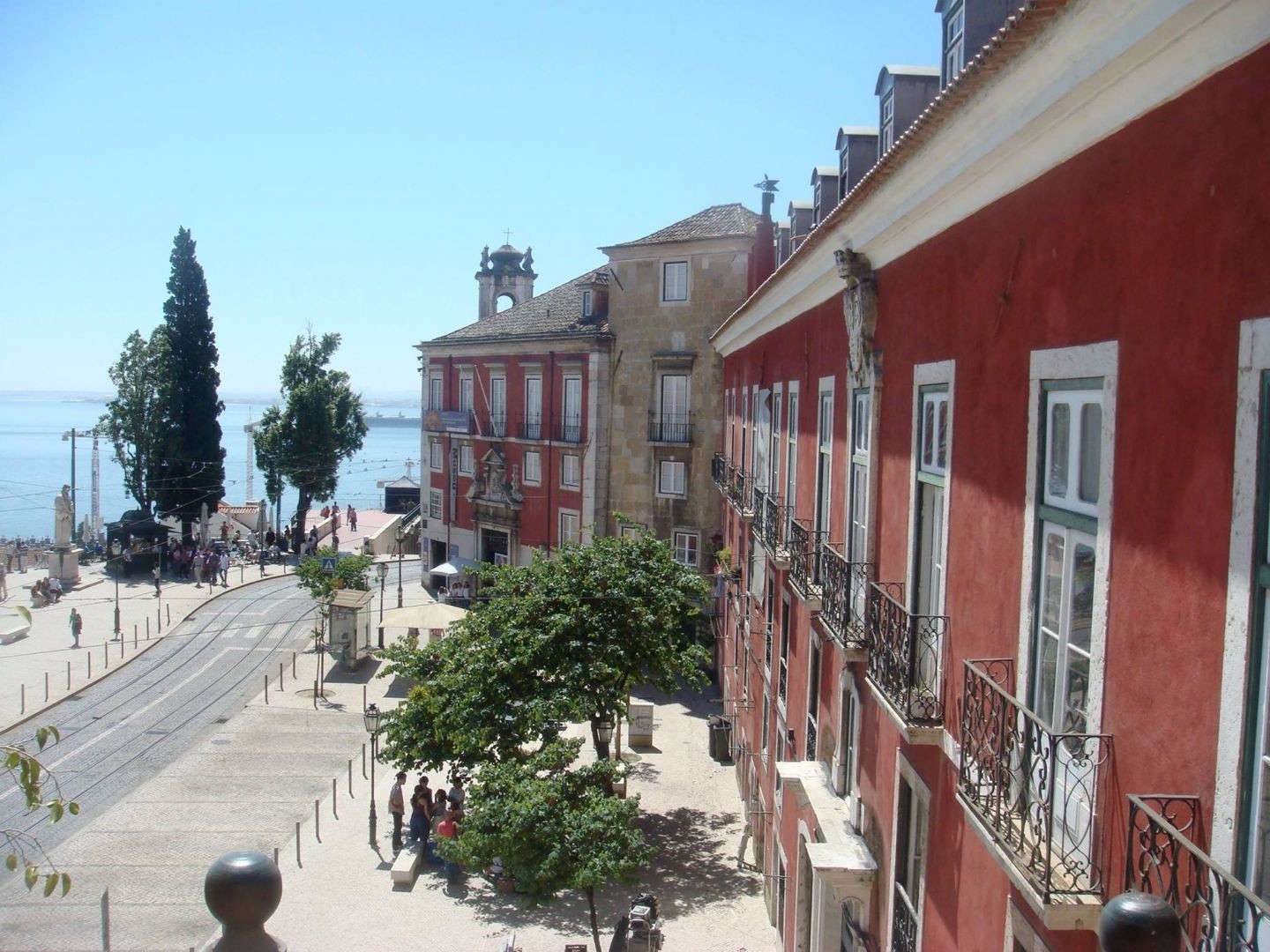
Castelo de Sâo Jorge
Logically, the castle is situated on the tallest hill in Lisbon. From some points, you can see the whole city. It's well known that in the Roman period, there existed some sort of defensive wall in its place. The Romans left Lisbon in 409 BC and during the year 300, it was occupied by the Visigoths right up until the arrival of the Arabs in 714 BC. They created their own fortress in the place of the Roman remains. Its centre was the "Alcaçova", a palace which we could visit.
After the year 400 during which the Christians and Muslims coexisted in peace, Alfonso Henriques arrived in the year 1147 and a terrible battle took place. There was destruction, violence, pillaging and crime. The Arab palace served as a palace to the Christian Kings until 1511 when they moved to the new palace of Ribiera.
The external walls are Roman and they are also the oldest, they closed off the castle and a district of Lisbon. Through the Arc of Sâo Jorge we came to this closed off district with narrow streets - the homes here are very sought after.
In the north east we saw the church of Santa Cruz do Castelo, it is built on top of a Mosque. We advanced a little and we went in the castle where we saw a big square with a statue of Alfonso Henriques and a series of cannons. From here, we enjoyed the views of "Baixa". We wandered past the wall and well looked after gardens. We went up to a tower that has a dark camera, very strange; the camera has lenses that also act as binoculars.
We saw a few remains of the restored "Alcaçova". The Olisiponia is an exhibition that tells an audiovisual story of Lisbon. We went down some stairs to the tower of Sào Lourenço. There was a kiosk where we could buy some drink cans because it was quite hot.
The castle is free to visit and the Olisiponia costs a moderate price to visit.
We continued on to the church of Graça.
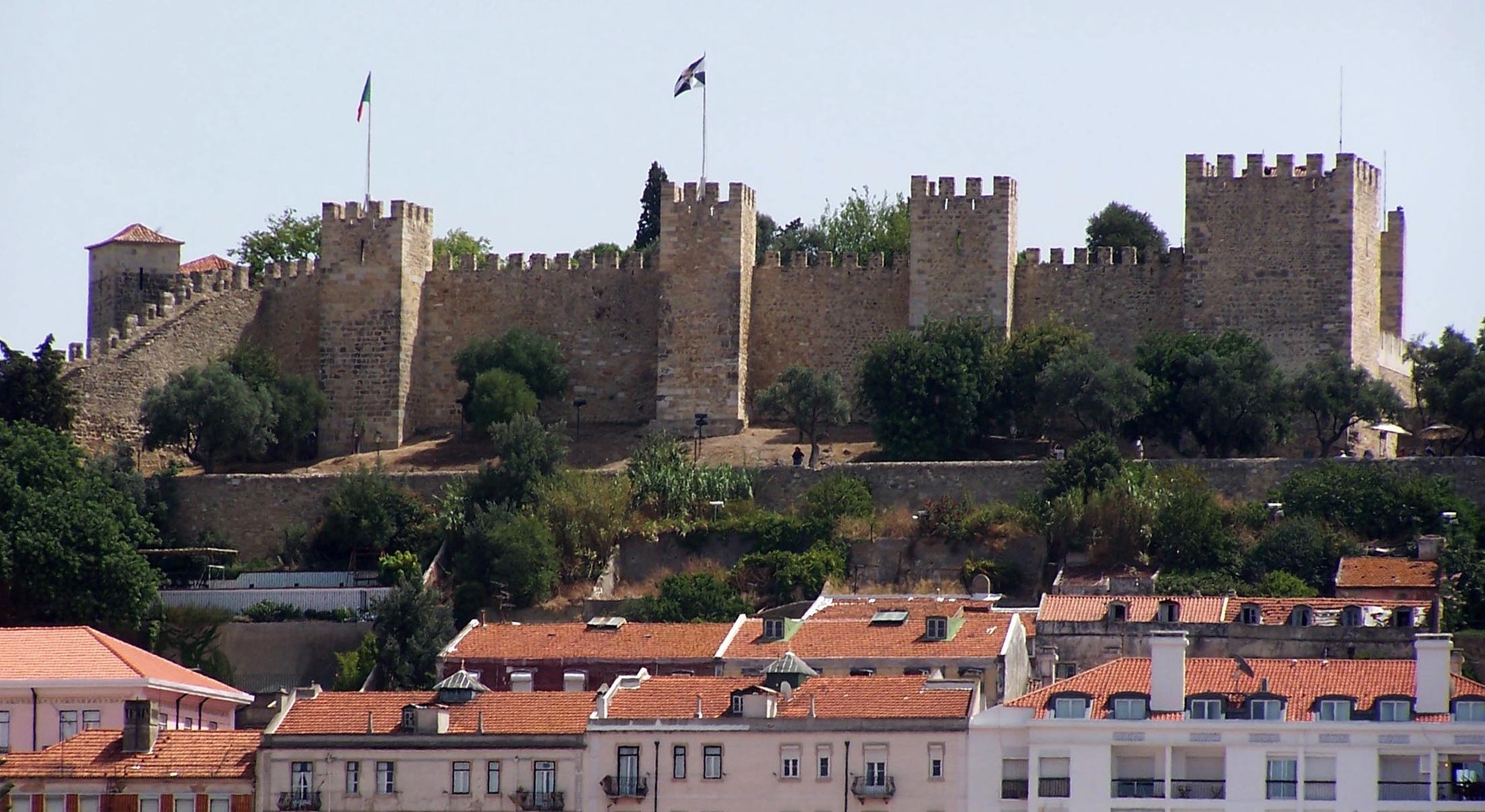
Igreja da Graça
On an esplanade with a lookout point, we found this church the was rebuilt after the earthquake. During the 18th century there was a monastery and the church. In 1834, they stopped building the monastery and only built the church. During Lent, the procession of "Senhor dos Passos" goes through the district where the church is located. The architect who took on the restoration of the church was Tomás Caetano de Sousa and he restored the church in a Baroque style. It has a floor shaped like the crucifix and a vault. The walls have tiles and chapels which are golden and this is all in the Rococo style.
We ate lunch in on the esplanade of the church. Some delicious peri-peri chicken. We went up to the "Rua Damasceno Monteiro" and the "calçada do monte" and we stopped for a moment and enjoyed the view from the lookout point of "Nossa Senhora do Monte". We continued the excursion to the "National graveyard of Santa Engracia" in "El campo de Santa Clara".
The National graveyard of Santa Engracia
Since 1916 this graveyard has been one dedicated to Portuguese heroes. It has a big dome. The church was built in the year 1683, it imitates Saint Peter's Basilica in Rome but the dome is further back. It was finished in 1966. The original church was demolished in 1630 because a Jewish person was accused of stealing from the church and therefore, desecrating it. The Jew said that it was a false accusation, so he put a curse on the new church and said it would never be finished. The interior has polychrome marbles. The famous Fado singer, Amalia Rodrigues is buried here. We saw some monuments of "Enrique the Navigator" and of the "Vasco da Gama".
The entry fee is cheap.
On leaving the graveyard and church, we took the number 28 tram to visit "San Vincente de Fora".
San Vincente de Fora
This church was built in honour of Saint Vincent, patron of Lisbon, in order to commemorate the expulsion of Muslims from the city. It was built in 1147 outside of the city's walls and that's where it got it's name from. The dome caved in during the earthquake in 1755 and lot's of people consequently died. It was restored in a Baroque style by high-status architects. It has a grand staircase which the whole of Lisbon liked, so they even copied the architecture in Brazil. The floor is in the shape of the Greek cross. The walls are adorned with tiles, it has a big central nave. We saw a precious golden altar. We also visited the cloisters and the two patios. The sacristy had polychrome marbles. The refectory is a graveyard for the Portuguese Kings from the Bragança family since 1885. A tiled staircase brought us to a bigger floor. The fables of La Fontaine were represented in this room.
It was Tuesday and we wanted to take advantage of being able to visit the Mercado de Feria da Ladra (the thieves market) which is set up on Saturday's and Tuesday's in the area of Santa Clara. From a long time ago, the sellers set up their stalls and lay out their products on the floor or on tables and they sell absolutely anything, new or used, but that's normal in a flea market. They sell very cool things. We bought some tiles and old books.
There's also a food market set up towards the back of the flea market, but we didn't have time to see it. It's called the "Mercado de Santa Clara".
We went down to the river and we visited the "Casa do Fado" on the street of "Chafariz de Dentro".
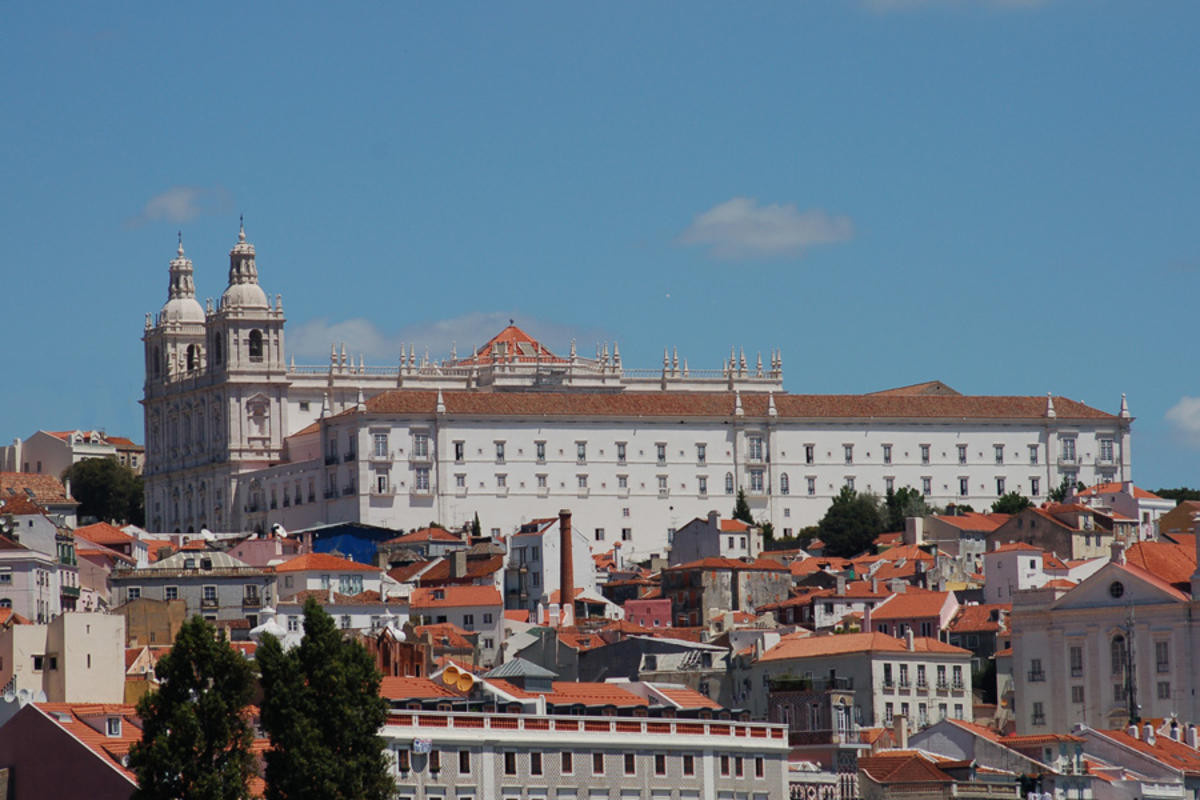
Saint Vincent of Fora monastery
Casa de Fado
It was inaugurated in the year 2000. In this museum, the museum teaches everything you'd need to know in the world of "Fado". There were recordings, posters, exhibitions and even demonstrations of the music. There was also a workshop where they built typical Portuguese guitars and an old Fado house. Fado is a type of music from the 19th century.
Opening times: from Tuesday till Sunday, from 10:00 till 17:30. Entry is cheap.
We took the bus to get to the national tile museum on "Rua da Madre de Deus". I can't remember what number bus we took but we took it to the back of the "Casa de Fado". The entrance was a little expensive, but they did have a student discount.
Museu Nacional do Azulejo
It is located in what was a convent and its church. It was a Franciscan convent, Madre de Deus, founded by Queen Lenour in 1509. It continued to be owned by her family until the religious orders were eliminated in 1834. With the riches coming from Brazil, the church transformed itself and covered itself in gold, marble, paintings and tiles. In 1971, it was chosen to be the museum that we have today. The Portuguese word for tile, which is azulejo, comes from two different words: "azraq" (sky blue) and "zalayja" (polished terracotta) or otherwise known as "polished terracotta painted blue".
We saw how the typical tiles from Lisbon are made. At first, they appeared as if they were from the 16th century. They were importing tiles from Seville until they learnt how to make the tiles themselves. We found a 23 metre tile which depicted the whole 14km coastline of Lisbon before the earthquake. It was made in the year 1700, it depicted the hills, the towers of the churches and the castle. In the cloister we also saw beautiful tiles.
Here, we took some very nice photos, putting our faces in a board that made our faces look like they were tiles depicting people from the 16th century. From here we passed by the church that had left us open-mouthed. There was a group of French kids in the museum scattered around and drawing the tiles. I think they did very well, but it made me a little jealous. There was a nice shop where we bought a little box of tiles and an inner courtyard where we had a Coca-Cola.
Opening times: Tuesday: from 14:00 until 18:00 and from Wednesday until Sunday: from 10:00 until 18:00. The entrance fee is moderate.
Today, there were no more excursions. We passed by the port and Alfama and we ate our dinner in our beautiful apartment in "Beco da Lapa". Beco is the street on which we can't park our car so we have to take the stairs to our apartment.
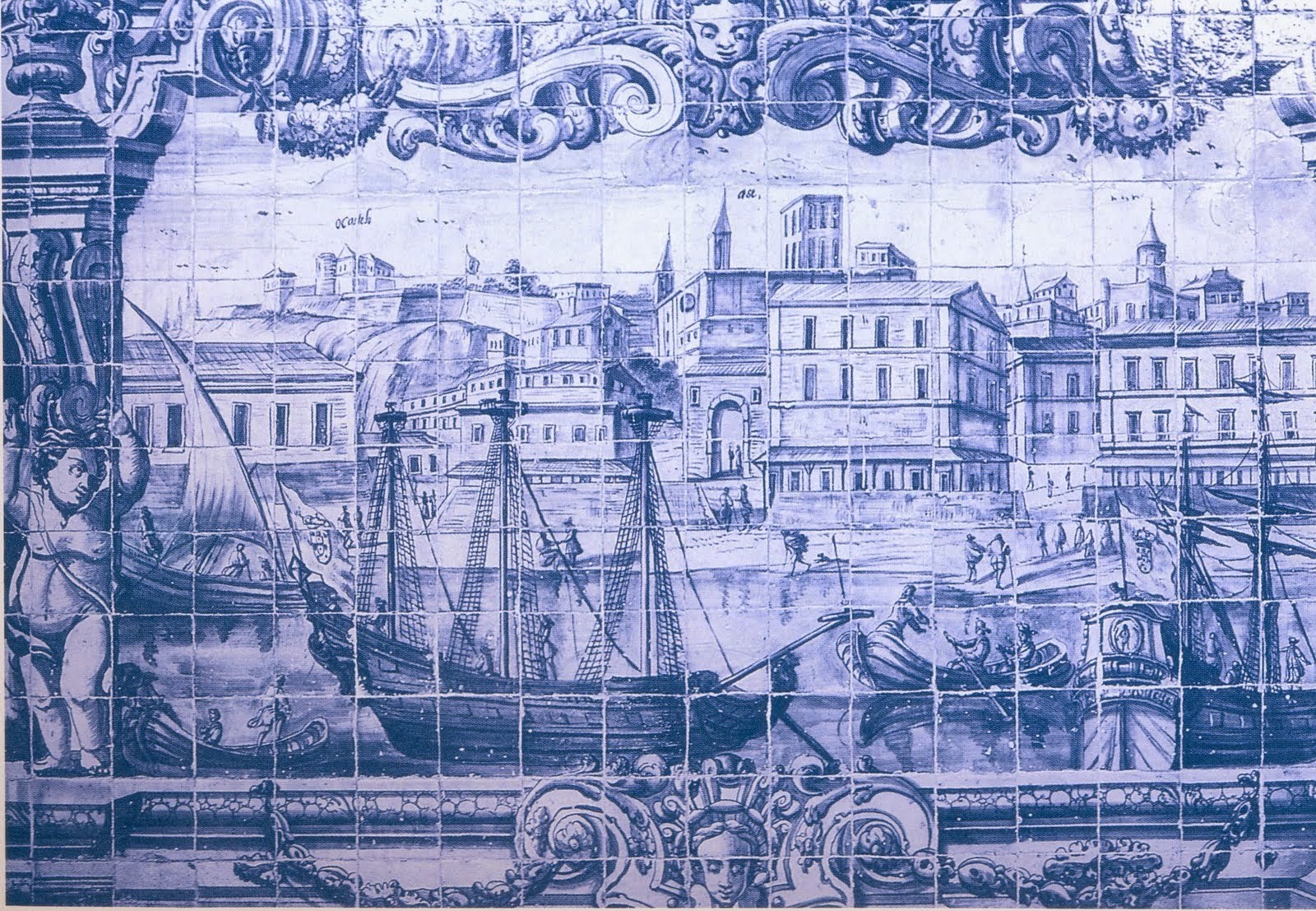
Photo gallery
Content available in other languages
- Español: Lisboa 1º parte
- Italiano: Lisbona (1º parte)
- Português: Lisboa 1ª Parte
Want to have your own Erasmus blog?
If you are experiencing living abroad, you're an avid traveller or want to promote the city where you live... create your own blog and share your adventures!
I want to create my Erasmus blog! →























Comments (0 comments)